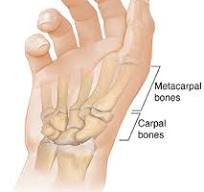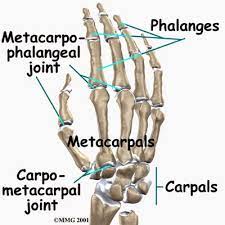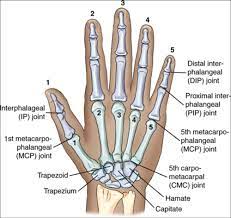

 The carpometacarpal (CMC) joints are five joints in the wrist that articulate the distal row of carpal bones and the proximal bases of the five metacarpal bones.
The carpometacarpal (CMC) joints are five joints in the wrist that articulate the distal row of carpal bones and the proximal bases of the five metacarpal bones.
The CMC joint of the thumb or the first CMC joint, also known as the trapeziometacarpal (TMC) joint, differs significantly from the other four CMC joints.
The carpometacarpal joint of the thumb (pollex), also known as the first carpometacarpal joint, or the trapeziometacarpal joint (TMC) because it connects the trapezium to the first metacarpal bone, plays an irreplaceable role in the normal functioning of the thumb.
The most important joint connecting the wrist to the metacarpus, osteoarthritis of the TMC is a severely disabling condition; up to twenty times more common among elderly women than in average.
Pronation-supination of the first metacarpal is especially important for the action of opposition.
The movements of the first CMC are limited by the shape of the joint, by the capsulo-ligamentous complex surrounding the joint, and by the balance among involved muscles.
If the first metacarpal fails to sit well ‘on the saddle’, the first CMC joint tends to slightly displaced towards the radius.
The capsule is sufficiently slack to allow a wide range of movements and a distraction of roughly 3 mm, while reinforcing ligaments and tendons give stability to the joint.
It is slightly thicker on its dorsal side than on the other.
The first carpometacarpal joint is a frequent site of osteoarthritis in postmenopausal women.
Three intracapsular and two extracapsular ligaments to be most important in stabilizing the thumb:
Anterior oblique ligament (AOL)
A strong, thick, and intracapsular ligament originating on the palmar tubercle of the trapezium inserted on the palmar tubercle of the first metacarpal.
It is taut in abduction, extension, and pronation.
It has an important retaining function and to be elongated or absent in CMC joint arthritis.
Ulnar collateral ligament (UCL) is
an extracapsular ligament, the UCL is located ulnarly to the AOL.
It has its origin is the flexor retinaculum and is inserted on the ulnopalmar tubercle of the first metacarpal.
It is taut in abduction, extension, and pronation, and often elongated in connection to CMC joint arthritis.
The First intermetacarpal ligament (IML) connects the bases of the second and first metacarpals.
IML this inserts onto the ulnopalmar tubercle of the first metacarpal where its fibers intermingle with those of the UCL.
It is taut in abduction, opposition, and supination.
It has been reported to be the most important restraining structure of the first CMC joint.
Posterior oblique ligament (POL) is not considered an important ligament to the first CMC joint, it tightens during forced adduction and radial abduction.
Dorsoradial ligament (DRL) is
not considered important to the first CMC.
In carpometacarpal articulation the movements permitted are flexion and extension in the plane of the palm of the hand, abduction and adduction in a plane at right angles to the palm, circumduction, and opposition.
The movement of opposition occurs when the tip of the thumb is brought into contact with the volar surfaces of the slightly flexed fingers.
Opposition movement is effected through the medium of a small sloping facet on the anterior lip of the saddle-shaped articular surface of the greater multangular (trapezium) bone.
The flexor muscles pull the corresponding part of the articular surface of the metacarpal bone on to this facet, and the movement of opposition is then carried out by the adductors.
Flexion of this joint is produced by the flexor pollicis longus and brevis, assisted by the opponens pollicis and the adductor pollicis.
Extension is effected mainly by the abductor pollicis longus, assisted by the extensores pollicis longus and brevis.
Adduction is carried out by the adductor; abduction mainly by the abductor pollicis longus and brevis, assisted by the extensors.
Range of motion for the first CMC is 53° of flexion/extension, 42° of abduction/adduction, and 17° of rotation.
The thumb’s MP and CMC joints abduct and adduct in a plane perpendicular to the palm(palmar abduction).
These joints flex and extend in a plane parallel to the palm, also referred to as radial abduction, as the thumb moves toward the hand’s radial side.
Abduction and adduction occur around an antero-posterior axis, while flexion and extension occur around a lateral axis.
Male and female thumb CMC joints are different.
In women, the trapezial articular surface is significantly smaller than the metacarpal surface, and its shape also differs from that of males.
The second metacarpal articulates primarily with the trapezoid and secondarily with the trapezium and capitate.
The third metacarpal articulates primarily with the capitate.
The fourth metacarpal articulates with the capitate and hamate.
Among themselves, the four ulnar metacarpals also articulates with their neighbours at the intermetacarpal articulations.
These four CMC joints are supported by strong transverse and weaker longitudinal ligaments: the dorsal carpometacarpal ligaments and the volar or palmar carpometacarpal ligaments.
The interosseous ligaments connect the contiguous inferior angles of the capitate and hamate with the adjacent surfaces of the third and fourth metacarpal bones.
The carpometacarpal joints of second through fifth digits are arthrodial.
The range of motions in these joints decrease from the fifth to the second CMCs.
The second to fifth joints are synovial ellipsoid joints with a nominal degree of freedom of flexion/extension.
The second and third joints are almost essentially immobile and considered to have zero degrees of freedom in practice, but capable of anteroposterior gliding movements.
The second and third CMC however also capable of small degree of flexion-extension motion, 11 degrees of flexion-extension motion for the second, while 7 degrees for the third.
The second and third CMC provide the other three CMCs with a fixed and stable axis.
The fourth CMC joint thus is a saddle joint with two degrees of freedom which except flexion/extension also enable abduction/adduction and a limited amount of opposition.
Together the movements of the fourth and fifth CMCs facilitates for their fingers to oppose the thumb.
The function of the finger carpometacarpal joints and their segments overall is to contribute to the palmar arch system together with the thumb.
The concavity of this arch is augmented at the level of the metacarpal heads by the flexibility of the first, fourth, and fifth metacarpal heads around the fixed second and third metacarpal heads.
For each finger there is also a longitudinal arch, and these arches allow the palm and the digits to conform optimally to objects as we grasp them.
As the fingers are being flexed, palmar cupping is contributed to by muscles crossing the carpometacarpal joints when they act on the mobile parts of the palmar arch system.
The synovial membrane is a continuation of that of the intercarpal joints.
Osteoarthritis of the carpometacarpal joints is a type of joint disease that results from breakdown of joint cartilage and underlying bone.
When it affects the thumb it is termed trapeziometacarpal osteoarthritis.
